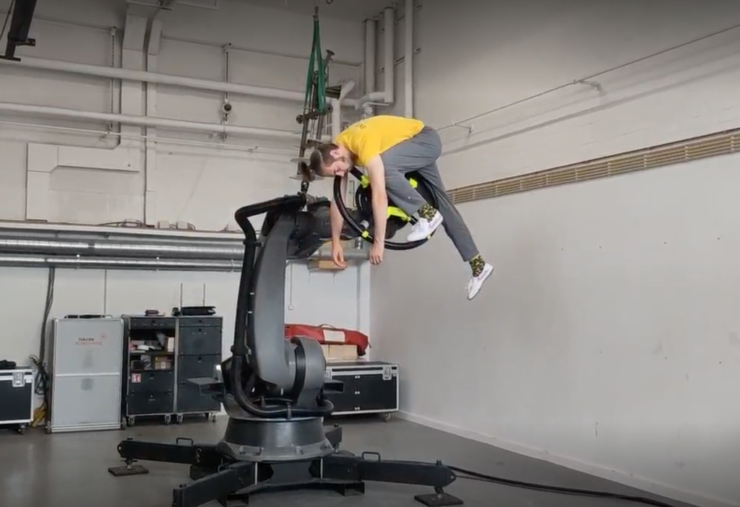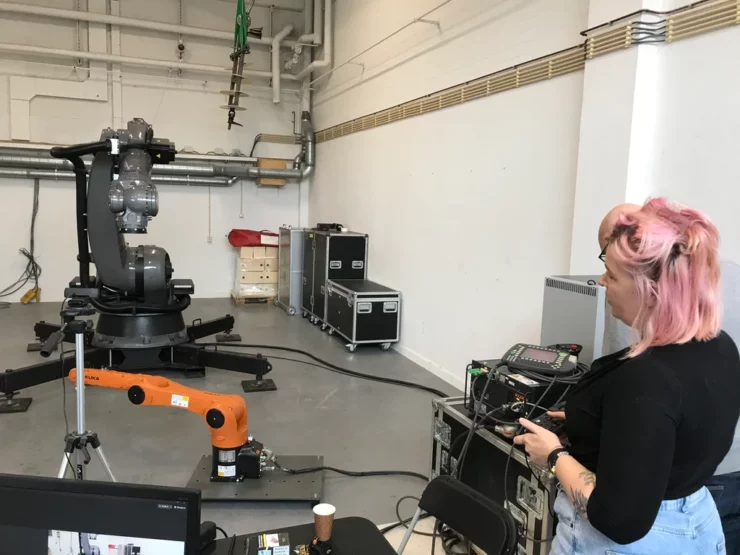Blog Posts
Manual Manipulation of the KUKA: Improvisation and Safety On/Off Stage – Stepan Laštuvka
December 2023
This ELRAT sprint was focused on manual (real-time) manipulation of the KUKA robots in the context of the performing arts, which brings about specific concerns of safety. Firstly, manual manipulation via a remote control was pointed out in the preceding sprint for the possibility of robot expressing a more thoughtful movement or a sense of improvisation, which may be relevant for various artistic projects. However, as a result of that, the robots that carry a large amount of power become less predictable and, in turn, potentially dangerous to human actors in their proximity.
More specifically, the KUKA robots may put others who interact with them in danger due to two general factors. Firstly, these robots are designed for heavy industrial labor without frequent interactions with humans and safety features corresponding to such a context (see fig. 1 and 2 for a comparison). Secondly, manual manipulation opens the scope for unexpected actions by the robot, especially if those who manipulate the robot lack extensive experience with it. Therefore, when manipulated manually, the KUKA robot may act unpredictably with no predetermined safety features that would stop the robot from putting human performers at risk. Moreover, manual manipulation also complicates the work of a performer or actor who can no longer act based on a knowledge of a specific preprogrammed movement of the robot. In response to these difficulties, this event aims to explore how manual manipulation of the KUKA robots could become safer in interaction with human performers or in the context of theatre and performing arts more broadly.

Figure 1. KUKA robot in the Volkswagengroup production line.

Figure 2. KUKA robot in the context of the ELRAT Sprint, with circus artist and performer Daniel Simu.
The event began with Rick van Dugteren, who introduced ideas, technologies and their affordances that could make manual manipulation of the robots easier and safer. Firstly, if the robot should be manipulated manually on stage in a theatre with other performers, it would need a piece of software that enables additional safety features, such as stopping the robot based on proximity to others or speed. This software would enable to gear the robot with specific predetermined safety features. This would extend the existing in-built safety features that are currently oriented towards protecting the robot rather than the surrounding environment.
Moreover, van Dugteren linked an Xbox controller with the robot to introduce an experiment on whether and how it may help to make manual manipulation more accessible for those without prior experience of navigating the robot. The Xbox is much simpler than the original KUKA controller, therefore it also lacks certain features, making the movement of the robot more limited as a result. Marijke Hessel was the first person to try out manipulating the KUKA via the Xbox controller. In response, it had been observed how some movements of the robot came about unexpectedly for the one navigating the robot. Similarly, when Jimmy-Pierre de Graaf tried out, at a certain point the robot just stopped moving, which came about unexpectedly as well. In this way, the experimentation highlighted that training in manipulating the KUKA manually and developing the skills or sensitivity for engaging with the robot is crucial for acting safely in close proximity to human performers. In this way, the experiment highlighted how both the said software but also training in manual navigation of the robot hold an equally relevant part to ensure safety for human performers coming into close proximity with the robot.

Figure 3. Marijke Hessel testing the Xbox controller for manual manipulation of the orange KUKA robot.
In light of the presentation of the software, technological affordances and subsequent experimentation with the Xbox controller, the discussion brought about a number of new reflections and ideas. Firstly, it helped highlight the importance of skill and sensitivity in the act of manual manipulation of the KUKA robots. In this vein, manual manipulation of the robots was discussed in comparison to the skills of puppeteering.
However, in the case of robots, it carries the safety issues brought about by the robot’s sheer amount of power, material and design. To this point, for those who manipulate the robot, the ability to orient themselves in relation to the robot becomes crucial for ensuring the safety of other performers. Furthermore, the present technological set-up inspired new ideas for potential artistic engagement. For example, it was discussed whether instead of using an Xbox controller, could the robot’s movement be linked to a human body via motion capture technology. In this way, an artist may also prerecord movements or sequences and store them for later use. This sprint concluded with these reflections that serve as thoughts for upcoming meetings in which they could be further elaborated on.
In summary, the event offered a foundation for addressing safety concerns during manual manipulation of the KUKA robots and, in turn, it also inspired further reflection on specific technological affordances and their limitations in the context of performing arts.
References
Volkswagengroup. 2023. “What robots in automative production look like and do.” Last Accessed October 19, 2023. https://modo.volkswagengroup.it/en/mobotics/what-robots-used-in-automotive-production-look-like-and-do

